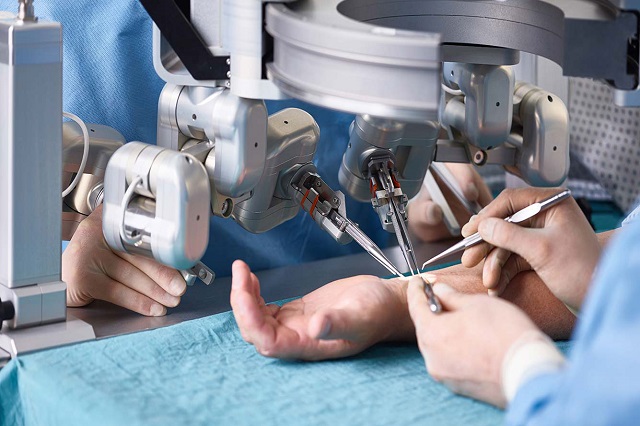Benefits of Robotic Surgery
In the field of medicine, robotic surgery has revolutionized the way complex procedures are performed. With advancements in technology, robotic surgery offers numerous benefits to patients and medical professionals alike. In this article, we will explore the advantages of robotic surgery and how it has transformed the healthcare industry.
Enhanced Precision and Accuracy
One of the key advantages of robotic surgery is its ability to provide enhanced precision and accuracy. The robotic system allows surgeons to perform intricate procedures with greater control and dexterity. The robotic arms can make precise movements that are not possible with human hands alone. This increased precision minimizes the risk of errors and complications during surgery, leading to improved patient outcomes.
Reduced Scarring and Faster Recovery
Robotic surgery offers the benefit of smaller incisions compared to traditional open surgery. The robotic instruments are designed to fit through tiny incisions, resulting in reduced scarring and less trauma to the surrounding tissues. Smaller incisions also lead to faster recovery times for patients. They experience less pain, require shorter hospital stays, and can resume their daily activities sooner than with traditional surgery.
Minimal Blood Loss and Infection Rates
With robotic surgery, the risk of blood loss during procedures is significantly reduced. The robotic instruments are equipped with advanced technology that cauterizes blood vessels as they operate, minimizing bleeding. Additionally, the robotic system provides a sterile environment, reducing the risk of infections. The precise movements of the robotic arms and the use of sealed instruments help maintain a clean surgical field, ensuring optimal patient safety.
Improved Visualization and 3D Imaging
Robotic surgery incorporates high-definition cameras and 3D imaging, allowing surgeons to have a magnified and detailed view of the surgical site. This enhanced visualization enables surgeons to identify and navigate complex anatomical structures with greater ease. The 3D imaging provides depth perception, making it easier to perform intricate maneuvers during surgery. Improved visualization leads to more accurate surgical interventions and better patient outcomes.
Greater Reach and Flexibility
The robotic arms used in robotic surgery have a greater range of motion compared to human hands. This allows surgeons to access hard-to-reach areas within the body more easily. The robotic instruments can bend and rotate in ways that human hands cannot, providing greater flexibility during surgery. This advantage is particularly beneficial in procedures that require delicate maneuvers or when operating in confined spaces.

Robotic surgery offers a multitude of benefits, ranging from enhanced precision and accuracy to reduced scarring and faster recovery times. The advantages of robotic surgery have transformed the field of medicine, improving patient outcomes and revolutionizing surgical procedures. With ongoing advancements in technology, robotic surgery is expected to continue evolving, further enhancing its benefits and becoming even more widespread in the future.
Frequently Asked Questions about the Benefits of Robotic Surgery
1. What is robotic surgery?
Robotic surgery is a minimally invasive surgical technique that uses robotic systems to assist surgeons during procedures.
2. How does robotic surgery differ from traditional surgery?
Robotic surgery offers enhanced precision, control, and visualization for surgeons compared to traditional open surgery or laparoscopic techniques.
3. What are the main benefits of robotic surgery?
The benefits of robotic surgery include smaller incisions, reduced blood loss, faster recovery, less pain, and improved surgical outcomes.
4. Can robotic surgery be used for all types of procedures?
Robotic surgery can be utilized for various procedures, including but not limited to prostate surgery, gynecological surgery, colorectal surgery, and cardiac surgery.
5. Is robotic surgery safe?
Robotic surgery is considered safe when performed by trained and experienced surgeons who follow proper protocols and guidelines.
6. Does robotic surgery result in less scarring?
Yes, robotic surgery often leads to smaller incisions, resulting in minimal scarring compared to traditional open surgery.
7. Are there any risks associated with robotic surgery?
As with any surgical procedure, there are risks involved in robotic surgery, but they are generally lower compared to open surgery. Potential risks include infection, bleeding, and anesthesia complications.
8. How long does it take to recover from robotic surgery?
Recovery time after robotic surgery is typically shorter compared to traditional surgery, with most patients experiencing a faster return to normal activities.
9. Are there any limitations to robotic surgery?
Robotic surgery may not be suitable for all patients or all types of procedures. Factors such as patient anatomy and medical history can influence the decision to use robotic surgery.
10. Does insurance cover robotic surgery?
Insurance coverage for robotic surgery varies depending on the specific procedure, insurance provider, and individual policy. It is recommended to check with your insurance company for details.




